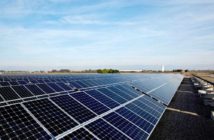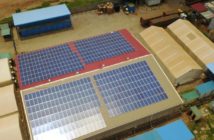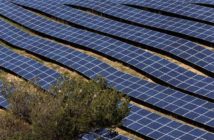Siemens’ decision to pull out of DESERTEC reignites doubts.
Devin Powell

Solar thermal power plants offer one option for supplying Europe with electricity through the DESERTEC project (artist’s concept).
DESERTEC/BRIGHTSOURCE
Dimming prospects for solar energy have caught up with a massive renewable-energy project planned for the Sahara Desert. By 2050, according to its backers, DESERTEC, a network of solar plants and other renewable sources scattered across North Africa and the Middle East, could generate more than 125 gigawatts of power that could be used locally or delivered to Europe through high-voltage direct-current cables beneath the Mediterranean Sea. But one of its major backers, Siemens, based in Munich, Germany, now says that it will leave Dii, the consortium trying to advance DESERTEC, by the end of the year.
“We see our part in Dii as done,” says spokesman Torsten Wolf of Siemens, one of 13 founding partners of the consortium, which is also based in Munich.
Related stories
Energy: Supergrid
Not so sunny after all
Europe looks to draw power from Africa
More related stories
Siemens also said that it will pull out of the solar-energy business altogether. Its decision was made in response to falling government subsidies for solar energy and a collapse in the price of solar equipment. But to DESERTEC’S critics, Siemens’ exit also adds to doubts about the plan, which is expected to cost hundreds of billions of dollars. “DESERTEC is an ambitious attempt to do everything at once,” says Jenny Chase, an analyst at Bloomberg New Energy Finance in Zurich, Switzerland. “I think it’s something that will be achieved organically, bit by bit, which will probably be cheaper, easier and achieve the same results.”
DESERTEC’s origins lie with retired particle physicist Gerhard Knies, who, after the 1986 Chernobyl nuclear disaster, had the idea of harvesting the Sahara’s plentiful sunshine for energy. With the help of Prince El Hassan Bin Talal of Jordan, Knies brought together research institutes in Germany and North Africa, including some in Morocco, Algeria and Egypt, to start looking into the idea.
“For generating electricity from renewable, carbon-free sources, the economics makes more sense if we go to the Middle East and North Africa,” says Ernst Rauch, Dii representative for the insurance company Munich Re, one of the consortium’s shareholders.
Siemens provided funds and technical expertise for preliminary studies, and in June, Dii published the result: a report that maps out the most cost-effective distribution of renewable-energy sources in 2050, based on simulations run by the Fraunhofer Institute for Systems and Innovation Research in Karlsruhe, Germany (see ‘Power play’).
Expand
Paul van Son, Dii’s chief executive, says that he is not concerned about losing Siemens for the next phase of the work, a detailed look at specific projects. “It will not really affect us,” he says, pointing out that Siemens is only one of dozens of shareholders and partners.
Siemens’ exit from solar energy is an about-face for the company, which had been investing in solar thermal energy, long considered a key feature of DESERTEC, after acquiring the solar-thermal equipment designer Solel, based in Beit-Shemesh, Israel, in 2009. Plants built with this technology use mirrors to concentrate sunlight on material that can absorb its heat. When released, the heat boils water, creating steam that can drive an electricity-generating turbine.
Solar thermal plants have become increasingly hard to sell in recent years, says Wolf, owing to the falling price of a competing technology, silicon solar panels. Between 2006 and 2012, the cost of these photovoltaic panels fell by around 65%, partly as a result of a glut of solar cells on the market. Waning government subsidies for solar installations have made staying in the business even harder by lowering the demand for solar power, says Matthew Feinstein, an analyst at Lux Research in New York.
“It’s been a bloodbath for the past year or so,” says Feinstein. Last December saw the bankruptcy of Berlin-based Solon, Germany’s first publicly traded solar company. Q.Cells, headquartered in Bitterfeld-Wolfen, one of the world’s top solar-cell producers, followed in March. Siemens’ exit from the business will deepen the gloom.
But Thiemo Gropp, director of the non-profit DESERTEC Foundation that set up Dii, says the fall in costs that drove Siemens out of the business will ultimately benefit the project. “Other companies will fill this gap with their own products,” he says. DESERTEC has endorsed one such project, a solar thermal plant planned for a site in Tunisia. Nur Energie, the London-based company behind the undertaking, hopes to supply Italy with power from the plant through an underwater cable.
And Siemens’ relationship with DESERTEC may not be entirely over. The company says that it still supports the mission in principle, and may have something to offer down the road. Wind energy, for example, has taken on an increasingly important role in plans for DESERTEC, which hopes to tap into Africa’s coastal winds. And Siemens now plans to focus on its wind portfolio.
The company has already received its first turbine orders from Africa. Morocco, which hopes to generate 6 gigawatts of power annually from renewable sources by 2020, bought 44 or them, to be installed at two wind farms. Although the projects have not been officially endorsed by DESERTEC, Wolf says that they fit the spirit of the endeavour perfectly.
Nature 491, 16–17 (01 November 2012) doi:10.1038/491016a
Related stories and links
From nature.com
Energy: Supergrid
01 December 2010
Not so sunny after all
21 January 2009
Europe looks to draw power from Africa
27 November 2007
Nature Collection: Energy
From elsewhere
DESERTEC Foundation
Dii
Gerald Knies on DESERTEC
Author information
Comments
Sorry, there was an error fetching comments for this article.
See other News & Comment articles from Nature
Model organisms: There’s more to life than rats and flies
Genetic tests: Politics and fetal diagnostics collide
Science in the developing world: Eritrea’s shattered science
Redhead pigment boosts skin-cancer risk
How women scientists fare in the Arab world
Seven days: 26 October–1 November 2012
Sahara solar plan loses its shine
NIH faces chimp housing quandary
Genomics: The single life
One-third of our greenhouse gas emissions come from agriculture
Arctic snow cover shows sharp decline
Oldest flying fish fossil found in China
Bid to curb fried-food chemical goes cold
L’Aquila verdict row grows
Hurricane Sandy spins up climate discussion
Theorists bridge space-time rips
Neanderthals smart enough to copy humans
Hepatitis E vaccine debuts
Leopard seals suck up krill like whales
Ancient tsunami devastated Lake Geneva shoreline
Scroll left
Scroll right
Journal navigation
Journal homeSubscribeCurrent issueE-alert sign upFor authorsRSS feed
Social Media Box – AML
E-alert
RSS
Facebook
Twitter
Top Content – Article Page
Recent
Model organisms: There’s more to life than rats and flies
Nature 31 October 2012
Genetic tests: Politics and fetal diagnostics collide
Nature 31 October 2012
Neuroscience: Found in translation
Nature 31 October 2012
Geography: Going all the way
Nature 31 October 2012
History: Realms of gold
Nature 31 October 2012
Read
Commented
Emailed
Science jobs from naturejobs
Faculty Position in Plant Evolutionary Biology – Assistant, Associate or Full Professor
Brown University
Assistant Professor in Microbiology / Immunology
Texas Tech University
Tenure Track Faculty Position in Innovative Fluorescence Technologies for Biological Applications
Carnegie Mellon University
Tenured Faculty Position – Quantitative Biological Networks
University of California San Diego
Postdoctoral Positions in Biophysics and Nanotechnology
Chalmers University of Technology – Dep of Chemical and Biological Engineering
Post a Free JobMore Science Jobs
.






